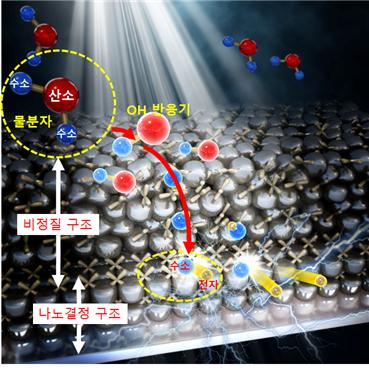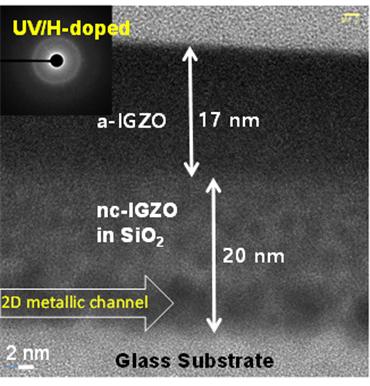- About Ajou
- Admission
- Academics
- Research
-
International
International
- Campus Life
-
News and Event
News and Event
-
AUT
AUT
Ajou News
NEW (2015-12-04)Ajou’s Professor Hyung Tak Seo succeeds in adjusting the electric conductivity of metal oxide semiconductors
- 2015-12-11
- 25804

Ajou’s Professor Hyung Tak Seo succeeds in adjusting the electric conductivity of metal oxide semiconductors by generating hydrogen
2015-12-04
Ajou University’s team led by Professor Hyung Tak Seo (Department of Materials Science and Engineering, Department of Energy System Research of the Graduate School, pictured above) succeeded in developing a technology that can dramatically raise electric conductivity with hydrogen that is generated by photochemically decomposing moisture absorbed into the surface of metal oxide semiconductors with ultraviolet radiation.
The research findings were published on October 27th in the online edition of The ACS Nano, a renowned academic journal in nano science. The research marks the world’s first reliable experimental confirmation of the possibility that hydrogen doping can adjust the electric conductivity of metal oxide semiconductors, which had previously only been speculated theoretically. Hence, the findings are expected to open up the possibility of developing highly efficient large-area semiconductors and transparent electrodes in the future.
Metal oxide semiconductors are made from straightened thin metal oxides and used as the essential elements in displays or transparent electrodes for solar batteries because they are transparent and their conductivity is easy to adjust. However, it had been difficult to obtain the expected performance due to the decrease in electric conductivity that occurs when metal oxides are made larger. Another problem had been that the electrical features of metal oxides change when moisture in the air lands on them and is resolved into hydrogen atoms.
The team of Professor Seo took note of the features of hydrogen atoms and designed ways to address the problems. The team exposed the surface of metal oxides – a mixture of Indium, Gallium, and Zinc Oxide – to high energy ultraviolet radiation to decompose the moisture into hydrogen. In doing so, they found that electrical conductivity increased in proportion to the length of time the surface was exposed to the ultraviolet radiation.
“Doping,” a method in which electrical conductivity is improved by adding impurities to semiconductors, was available in the past, but hydrogen, which is light and dissipates easily, has never been used. Professor Seo’s team used high-quality electromicroscopes and spectroscopes and confirmed that, as water molecules attached to the oxides change into hydrogen molecules, they combine with existing atoms in the gaps between atoms or in the spaces left by outgoing oxygen atoms within a thin membrane, which increases electron density. Depending on the trial, electrical conductivity increased by one-thousand billion times or higher. Thus, hydrogen doping was experimentally verified for the first time in the world.
In particular, electrical conductivity increased as much as 1011 times when hydrogen doping was conducted at room temperature after creating nano crystals on the interface of metal oxides and circuit boards by using alkali metallic impurities, compared to when no nano crystals were present. Professor Seo explained that the findings will allow for making highly reliable large-area oxide semiconductors and transparent electrodes necessary for the display industry, etc., through a simple process. Professor Seo added that the research will contribute to developing photochemical doping equipment that can be applied to transparent electrode technology by discovering the mechanism of hydrogen doping through the latest analytic techniques.
Professor Seo went on to say, "The photochemical doping technology that was proposed in the research involves an easier process, is highly efficient in adjusting electrical conductivity, and dramatically increases the reliability of oxides. Thus, it will be able to be utilized extensively in developing next-generation transparent elements."
The research was conducted in collaboration with the team of Professor Duck Kyun Choi from Hanyang University with the support of the Nano Material Technology Development Project and the General Researcher Support Project that are carried out by the Ministry of Science, ICT, and Future Planning and the National Research Foundation of Korea.

< Diagram of the concept of the photochemical hydrogen doping mechanism >

< A photo of hydrogen combined with nano crystals taken by a high-resolution transmission electromicroscope >
